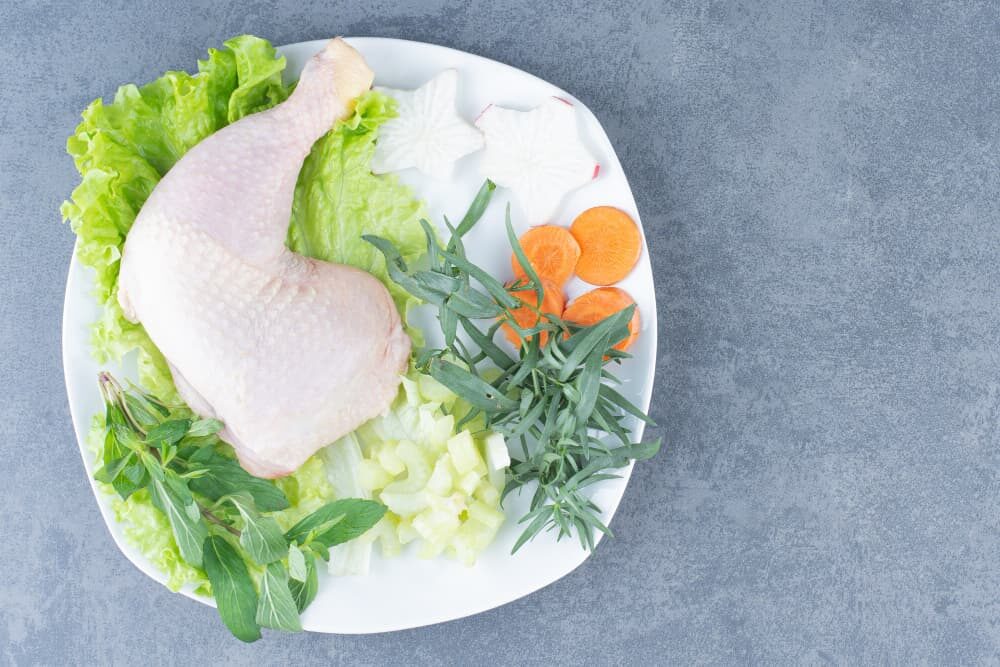Chicken thigh nutrition often gets a bad rap. Sure, chicken thighs are flavorful, affordable, and easy to cook—but are they too fatty to be considered healthy?
That’s a common concern for anyone trying to eat cleanly without giving up taste. Chicken breast tends to be the go-to lean option, while many avoid thighs due to their higher fat content.
But here’s the thing: that might be a mistake.
In this updated 2025 guide, we’ll break down the actual calories in chicken thigh—skin-on vs. skinless—explore key macros and look at how they stack up against other popular cuts like breast, wings, and drumsticks. You’ll get clear, accurate chicken thigh nutrition information to help you decide if this juicy cut belongs in your meal plan.
Let’s dive in before you write it off.
Chicken Thigh Nutrition at a Glance
Chicken thighs can vary quite a bit in nutritional content depending on how they’re prepared—and whether the skin is left on. Here’s a quick comparison of skin-on vs. skinless chicken thigh nutrition, based on a standard 100-gram (3.5 oz) cooked portion:
| Nutrient | Skin-On (100g) | Skinless (100g) |
| Calories | 229 kcal | 179 kcal |
| Protein | 24.4 g | 24.8 g |
| Fat | 14.6 g | 8.2 g |
| Cholesterol | 94 mg | 89 mg |
| Sodium | 82 mg | 70 mg |
💡 One average chicken thigh (cooked, skin-on) weighs around 116 grams, while a skinless thigh is closer to 100 grams. So if you eat a full piece, your intake will be slightly higher than the numbers above.
As the table shows, removing the skin cuts nearly 50 calories and 6 grams of fat—with almost no impact on protein. That makes skinless chicken thigh a leaner option while still delivering solid flavor and nutrition.
Chicken Thigh (Skin-On vs Skinless): What’s the Real Difference?
When it comes to chicken thigh nutrition, skin makes a big difference—not just in calories and fat, but also in taste and texture.
Here’s how the two versions stack up per 100 grams (cooked):
| Type | Calories | Protein | Fat | Flavor & Texture |
| Skin-On | 229 kcal | 24.4 g | 14.6 g | Richer, juicier |
| Skinless | 179 kcal | 24.8 g | 8.2 g | Leaner, lighter taste |
⚠️ Quick fact: Leaving the skin on can add 80–100 extra calories per piece, mainly from fat.
But fat isn’t always the enemy. Skin-on thighs offer a deeper flavor and satisfying crispness when roasted or grilled. That makes them great for occasional meals where taste takes priority.
💡 Trying to lose weight? Go skinless. You’ll cut nearly 40% of the fat while still getting almost the same amount of protein.
For high-protein, lower-calorie meals, skinless chicken thigh nutrition offers one of the best macro profiles of any cut of meat—without sacrificing much taste, especially when seasoned or slow-cooked properly.

How Cooking Methods Impact Nutrition
Chicken thighs are versatile—but how you cook them can make or break their nutritional value. Even the healthiest cut can become a calorie bomb with the wrong prep method.
Here’s how different cooking methods affect calories in chicken thighs per 100g serving (skinless, boneless):
| Cooking Method | Calories | Fat (g) | Protein (g) |
| Grilled | 179 kcal | 8.2 g | 24.8 g |
| Baked | 181 kcal | 8.5 g | 24.5 g |
| Pan-fried (light oil) | 210 kcal | 11.2 g | 24.1 g |
| Deep-fried (battered) | 238 kcal | 14.2 g | 23.5 g |
| Barbecue-glazed | 221 kcal | 10.1 g | 22.8 g |
🟨 Watch out for hidden calories:
Oils, breading, and sauces can easily add 50–100+ calories per serving. A grilled thigh with just herbs keeps it lean, while deep-frying or heavy glazes can double the fat content.
Cooking tip:
Use air fryers, roasting, or grilling with minimal oil to keep your chicken thigh nutrition in check—especially if you’re watching your fat intake.
Chicken Thigh vs Breast, Wing & Drumstick: Which One Wins?
Not all chicken cuts are created equal. Whether you’re trying to cut fat, build muscle, or just enjoy your food without blowing your macros, knowing how each part stacks up is key.
Here’s how the most popular cuts compare per 100g (cooked, skinless):
| Cut | Calories | Protein | Fat | Flavor |
| Thigh | 179 kcal | 24.8 g | 8.2 g | Rich, juicy |
| Breast | 165 kcal | 31.0 g | 3.6 g | Lean, mild |
| Wing | 203 kcal | 30.5 g | 8.1 g | Bold, crispy (when baked) |
| Drumstick | 155 kcal | 24.2 g | 5.7 g | Tender, flavorful |
🏋️ Best for Muscle Gain?
Chicken thighs offer a solid balance of protein and making them ideal for muscle-building meals that also keep you full. The extra fat can help with hormone production and overall calorie intake.
🥗 Best for Lean Diets?
Chicken breast wins on protein-to-fat ratio, perfect for strict cutting phases or very low-fat diets.
⚖️ Balanced Choice?
Drumsticks and thighs offer more flavor than breasts without going too high in fat, making them great for everyday meals.
✅ Trying to gain muscle? Chicken thigh might be the smarter choice.
It’s more satisfying than breast, easier to cook without drying out, and still packs nearly 25g of protein per serving.

Is Chicken Thigh Actually Healthy? Here’s What Research Says
Chicken thighs often get a bad rap due to their higher fat content—especially saturated fat. But the truth is more nuanced. Fat isn’t inherently bad, and when chicken thighs are prepared well, they can absolutely fit into a healthy diet.
🧠 The Saturated Fat Question
Yes, skinless chicken thighs contain around 2.5–3.0 grams of saturated fat per 100g, compared to about 1 gram in the same amount of chicken breast. That’s still within dietary guidelines for most people.
According to the American Heart Association, the recommended limit for saturated fat is no more than 5–6% of total daily calories—roughly 13g/day for someone on a 2,000-calorie diet. A skinless chicken thigh contributes a small fraction of that.
📝 Source: USDA FoodData Central (FDC ID: 170256) for cooked, skinless chicken thigh
🌿 Micronutrient Bonus: More Than Just Protein
Chicken thighs are also richer in key micronutrients compared to white meat:
- Vitamin B6 – supports brain function and energy metabolism
- Zinc – essential for immune system and wound healing
- Selenium – acts as a powerful antioxidant, important for thyroid health
Dark meat generally contains 10–20% more B vitamins and minerals than chicken breast, based on USDA nutrient data.
❤️ Satiety, Taste and Balanced Diets
Thanks to their higher fat content and richer flavor, chicken thighs tend to be more satisfying than leaner cuts. This can help curb cravings and support better portion control—especially important for people managing calorie intake.
A 2021 review published in Nutrients found that including moderate amounts of dark poultry meat in a balanced diet had no negative impact on cholesterol or cardiovascular risk markers in healthy adults.
✅ The Bottom Line
When prepared skinless and cooked with minimal oil, chicken thighs can be part of a healthy, nutrient-dense meal plan. They offer flavor, satisfaction, and key nutrients—without being a dietary red flag.
Chicken Thigh FAQ: Your Top Questions Answered
❓ How many calories in a skinless chicken thigh?
A cooked, skinless chicken thigh (about 100g) contains approximately 179 calories. One medium skinless thigh (around 95–100g) typically has 170–180 calories, depending on how it’s cooked.
❓ Is chicken thigh good for weight loss?
Yes—chicken thigh can support weight loss, especially when skinless and grilled or baked. It offers high protein to keep you full, and the fat content—though higher than breast—can increase satiety, which may help prevent overeating.
❓ Chicken thigh vs breast for protein—what’s better?
Chicken breast has more protein per calorie (31g protein per 165 calories), making it ideal for very lean diets. But chicken thighs still provide 25g of protein per 100g, with more flavor and slightly more fat—great for balanced or bulking diets.
❓ Can I eat chicken thighs every day?
You can, as long as they’re prepared healthily (grilled, baked, air-fried) and fit your overall macro goals. Opting for skinless chicken thighs helps control fat and calorie intake. Just balance with vegetables and whole grains.
❓ What’s the healthiest way to cook chicken thighs?
The healthiest cooking methods are grilling, baking, air frying, or steaming with minimal added oil. Avoid deep-frying or sugary sauces. Cooking skinless chicken thighs with herbs and spices brings flavor without excess calories.
❓ What’s the nutritional information for chicken thighs with skin?
A 100g cooked chicken thigh with skin contains about 229 calories, 24.4g protein, and 14.6g fat. The skin adds flavor but also increases saturated fat and calorie load by up to 100 calories per piece.
❓ Are chicken thighs high in cholesterol?
One cooked chicken thigh (100g) contains around 89–94 mg of cholesterol, which is about 30% of the recommended daily limit. It’s fine in moderation, especially if the rest of your diet is heart-healthy.
📌 About This Article & How It’s Reviewed
Nutrition Disclaimer
The nutritional information provided in this article is intended for general informational purposes only and does not constitute medical or dietary advice. While we strive to present accurate and up-to-date data based on reputable sources, individual health needs can vary significantly.
Always consult a registered dietitian, nutritionist, or healthcare provider before making changes to your diet, especially if you have any underlying health conditions. Nutrient values may also vary based on preparation methods, portion sizes, and brand differences.
This article was written by Stella Whitmore, a certified nutrition researcher and food writer, and reviewed by the Healiscope Editorial Team to ensure clarity, accuracy, and alignment with current evidence-based practices.
👉 Want to learn more about what’s in your food? Explore our full library of expert-reviewed articles on food and nutrition here.
Sources
- https://www.nutritionix.com/food/chicken-thighs
- https://www.medicalnewstoday.com/articles/326767
- https://www.healthline.com/nutrition/protein-in-chicken#bottom-line
- https://www.fsis.usda.gov/sites/default/files/media_file/2020-10/Chicken_Turkey_Nutrition_Facts.pdf
- https://www.ncbi.nlm.nih.gov/books/NBK570127/






